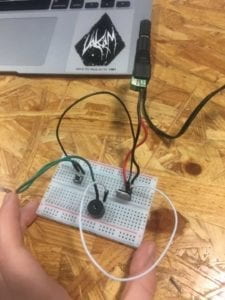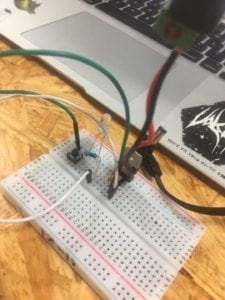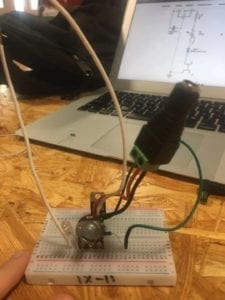For the first recitation we were asked to build simple circuits and link them to a pre-made Arduino code. Apart from building the circuits, we soldered wires to a switch, to make it easier to connect to the breadbox. The assignment was meant to enlighten us as to how to use the circuit board, and connect it successfully to the Arduino, and have the set code work with that circuit. I hoped to have a better grasp of the Arduino system itself, and borrowed the schematics given to us for the recitation to fulfill the requirements (as well as Arduino’s pre-made codes). This was with my partner, Emma Rose.
For the first one, we needed to connect a speaker (buzzer), and successfully make it turn on and make sounds. At first all the wires and notations on the schematics were confusing, but we quickly became accustomed and it turned out to be quite simple to connect the voltage regulator to the rest of the circuit. We accomplished the circuit!

The second circuit turned out to be even simpler, once we got accustomed to the voltage regulator and the differences between “input” and “ground” on the switch: it was basically just adding an LED to an already made circuit, foregoing the buzzer.

The third one, we at first thought was the hardest because we thought we had made a mistake in our initial setup; but it was just a matter of turning on the console part of the Arduino code and actually turning the potentiometer to see the difference in “energy flow”, or voltage: silly us!

At first we may had been a little overwhelmed, but we quickly figured the circuitry out and were able to make every single one successfully and with very little trouble, it was quite fun!
Question 1: The interactivity in these circuits were in the switches (or the knob in the case of the potentiometer). Without this added part of the circuit, I don’t think it would be fair to call it interactive, even of a low kind, because the computer did all the work. However, with a switch (or a knob), something else comes into play: the human aspect. This incorporates a simple, yet effective, interactivity for turning on sound, light, or regulating voltage.
Question 2: By turning circuits into something that can light up, or make sound, with the help of an outside entity, I believe this turns the circuits (the design and computing of it) into art. For example, with Remo Saraceni’s piano stairs: the person walking up or down the stairs becomes apart of the system and interacts with it in a way to make music, a.k.a. art.